
While the defence of Bermuda remains the responsibility of the government of the United Kingdom, rather than of the local Bermudian Government, the island still maintains a militia for the purpose of defence.

Glasgow Airport, also known as Glasgow International Airport, formerly Abbotsinch Airport, is an international airport in Scotland. It is located in Paisley, Renfrewshire, 8.6 nautical miles west of Glasgow city centre. In 2019, the airport handled 8.84 million passengers, an 8.4% annual decrease, making it the second-busiest in Scotland, after Edinburgh Airport, and the ninth-busiest airport in the United Kingdom.

L.F. Wade International Airport, formerly named Bermuda International Airport, is the sole airport serving the British overseas territory of Bermuda in the north Atlantic Ocean. It is located in the parish of St. George's and is 6 nautical miles northeast of Bermuda's capital, Hamilton. In 2016, the airport handled 402,925 passengers, up 5.6% from 2006. It has one passenger terminal, one cargo terminal, eight aircraft stands and can support all aircraft sizes up to and including the Airbus A380. Currently, nine passenger or cargo airlines operate seasonal or year-round scheduled services from the Azores, Canada, the United Kingdom, and the United States. The airport covers 536 acres of land and contains one runway.
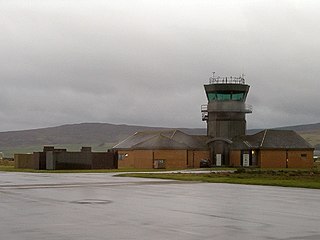
Royal Air Force Machrihanish or RAF Machrihanish is a former Royal Air Force station located near the town of Machrihanish and 3.5 miles (5.6 km) west of Campbeltown, at the tip of the Kintyre peninsula, Argyll and Bute, in Scotland.
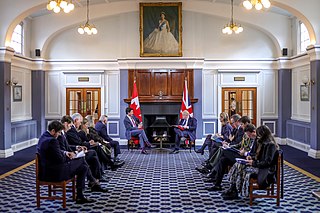
Royal Air Force Northolt or more simply RAF Northolt is a Royal Air Force station in South Ruislip, 2 nautical miles from Uxbridge in the London Borough of Hillingdon, western Greater London, England, approximately 6 mi (10 km) north of Heathrow Airport. The station handles many private civil flights in addition to Air Force flights. Northolt has one runway in operation, spanning 1,687 m × 46 m, with a grooved asphalt surface. This airport is used for government and VIP transport to and from London.

The destroyers-for-bases deal was an agreement between the United States and the United Kingdom on September 2, 1940, according to which 50 Caldwell, Wickes, and Clemson-class US Navy destroyers were transferred to the Royal Navy from the US Navy in exchange for land rights on British possessions.
Royal Air Force Nutts Corner, or more simply RAF Nutts Corner, is a former Royal Air Force (RAF) station located 2.7 miles (4.3 km) east of Crumlin, County Antrim, Northern Ireland and 9.2 miles (14.8 km) north west of Belfast.

Exeter Airport, formerly Exeter International Airport, is an international airport located at Clyst Honiton in East Devon, close to the city of Exeter and within the county of Devon, South West England. Exeter has a CAA Public Use Aerodrome Licence that allows flights for the public transport of passengers or for flying instruction. The airport offers both scheduled and holiday charter flights within the United Kingdom and Europe.

Kindley Air Force Base was a United States Air Force base in Bermuda from 1948–1970, having been operated from 1943 to 1948 by the United States Army Air Forces as Kindley Field.

Seletar Airport is a regional airport serving the north-east region of Singapore. It is located approximately 16 kilometres (9.9 mi) northwest from Changi Airport, the country's main airport, and about 16 kilometres (9.9 mi) north from the main commercial city-centre.

Mosul International Airport is an airport located at Mosul, capital of Nineveh Governorate, Iraq. It became a civil airport in 1990 with the rebuild of the runway and construction of a new terminal. After undergoing major renovations to be able to reach international standards and category 1 status, it reopened as a civilian airport on 2 December 2007. On 9 June 2014, it was captured by militants from ISIL.
The history of the Royal Air Force, the air force of the United Kingdom, spans a century of British military aviation.
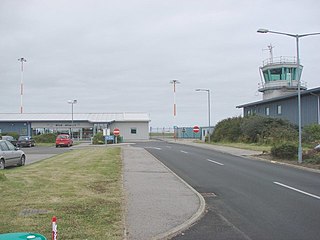
Wick John O' Groats Airport is located one nautical mile north of the town of Wick, at the north-eastern extremity of the mainland of Scotland. It is owned and maintained by Highlands and Islands Airports Limited. The airport provides commercial air travel connections for Caithness, with scheduled services to Aberdeen Airport and, until early 2020, Edinburgh. It remains regularly used by helicopters servicing local offshore oil operations and the Beatrice Offshore Windfarm. It also serves as a stop-over for light aircraft ferry flights between Europe and North America via Iceland. The airport also operates an out of hours call-out service for air ambulances, coastguard and police flights.

Naval Air Station Keflavik (NASKEF) was a United States Navy air station at Keflavík International Airport, Iceland, located on the Reykjanes peninsula on the south-west portion of the island. NASKEF was closed on 8 September 2006, and its facilities were taken over by the Icelandic Defence Agency as their primary base until 1 January 2011, when the Agency was abolished and the base handed over to the Icelandic Coast Guard, which has since then operated the base. US forces would return to Keflavik starting from 2016.
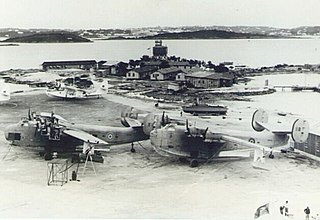
The Royal Air Force (RAF) operated from two locations in the Imperial fortress colony of Bermuda during the Second World War. Bermuda's location had made it an important naval station since US independence, and, with the advent of the aeroplane, had made it as important to trans-Atlantic aviation in the decades before the Jet Age. The limited, hilly land mass had prevented the construction of an airfield, but, with most large airliners in the 1930s being flying boats, this was not initially a limitation.
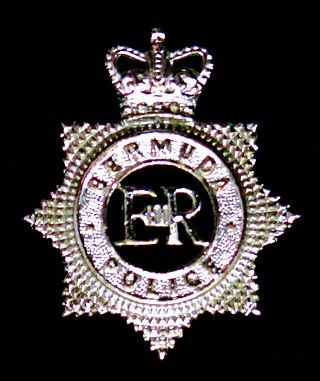
The Bermuda Police Service is the law enforcement agency of the British Overseas Territory and former Imperial fortress of Bermuda. It is responsible for policing the entire archipelago, including incorporated municipalities, and the surrounding waters. It is part of, and entirely funded by, the Government of Bermuda. Like the Royal Bermuda Regiment, it is under the nominal control of the territory's Governor and Commander in Chief, although, for day-to-day purposes, control is delegated to a minister of the local government. It was created in 1879, as Bermuda's first professional police service. In organisation, operation, and dress, it was created and has developed in line with the patterns established by British police services, such as the City of Glasgow Police, and the Metropolitan Police Service.

Naval Air Station Bermuda, was located on St. David's Island in the British Colony of Bermuda from 1970 to 1995, on the former site of Kindley Air Force Base. It is currently the site of Bermuda International Airport.

Airport police units are a security police agency assigned to perform law enforcement functions at airports. They provide a wide range of law enforcement duties and responsibilities including patrol, investigation, traffic flow management, and control and response to airport emergencies. Airport police provide enhanced safety to airport employees, and to passengers. Officers can be found at security gates, throughout the terminal area, and around the airport’s perimeter.

The Bermuda Base Command was a command of the United States Army, established to defend the British Colony of Bermuda, located 640 miles off Cape Hatteras, North Carolina. It was created in April 1941 when United States Army troops were sent to the island.

RNAS Bermuda was a Royal Naval Air Station in the Royal Naval Dockyard on Ireland Island until 1939, then Boaz Island, Bermuda. Bermuda became the primary base for the North America and West Indies Station of the Royal Navy in the North-West Atlantic following American independence. It was the location of a dockyard, an Admiralty House, and the base of a naval squadron.



















